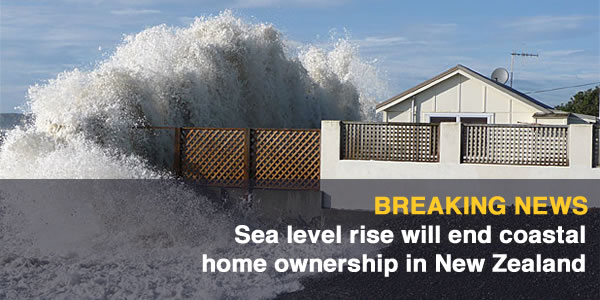On Thursday the Parliamentary Commissioner for the Environment (PCE) released a report which recommended the Finance Minister work with insurers, banks, local authorities and residents to develop a plan for sea level rise.
The Finance Minister’s response was that the report is “pretty speculative”, and that any sea rise was best dealt with by Local Authorities.
In a way, Bill English is right – the Government doesn’t have to do anything. However, they didn’t have to do anything about Christchurch either and yet they have. We have another Christchurch style disaster looming and as the Parliamentary Commissioner for the Environment has pointed out it makes a lot more sense to act now than later.
Potential cost of sea level rise
The Parliamentary Commissioner for the Environment has put a conservative price tag on a 50cm sea level rise at $9 billion. We know it is a conservative figure because it excludes below ground infrastructure like pipes and cables, which in Christchurch are proving very expensive to replace.
That $9 billion of damage won’t happen all at once like earthquakes tend to, but it is nonetheless a completely predictable natural disaster. Given the slow pace with which the world is reducing emissions, the full $20 billion cost for a 1.5m sea level rise seems pretty likely too, albeit on a longer time horizon.
The Finance Minister response implies the government will not have to foot any of the bill. Let’s have a quick look at the costs of rising sea levels and whether any of them will end up in the lap of government.
1.Public infrastructure
A big chunk of that $9-20b risk is public infrastructure – particularly roads – and remember those numbers don’t even include all public infrastructure like pipes. Some of this is local authority responsibility but some is central government – we are already seeing the Northwestern motorway in Auckland being raised. The Government needs a plan to ensure that risk doesn’t get any worse, and that over the next 30-50 years that at risk infrastructure gets moved to higher ground.
2. Private development
There are risks for government either way on private development. On the one hand landowners could sue the government or local authorities if improper areas are developed and they end up underwater. On the other hand, if local authorities become too risk averse we don’t want to lose the economic benefit from development where it should occur. It just has to be clear that the public sector – either government or local authorities – won’t be bearing any liability for the losses incurred when the sea level rises. Any new development has to occur at the risk of the property owner and their bank.
Another risk of private development is that owners will mount pressure to replace or build new infrastructure to protect private property such as sea defenses. Such proposals need to be pushed back, unless there is a clear business case backed by evidence. Kneejerk reactions risk being a waste of taxpayer’s money.
At the moment the Government’s plan seems to be to leave this to local authorities to solve. We have already seen the downsides of this approach – local authorities around the country are duplicating resources trying to solve the same problem, and generally doing a poor job. The net result has been Kapiti and Christchurch councils dragged through the courts, and the rest of councils have been paralysed into inaction.
3. Insurer of last resort
The insurance industry has already woken up to the risks of sea level rise, and is keen to engage in a public conversation. We can be certain that as the probability of floods rise, some homes will be increasingly expensive to insure. Eventually, the private insurers will walk away.
In 1945 the country realised that a fair chunk of the country is built on a fault line, so we invested in setting up the Earthquake Commission (EQC). We’d seen the damage earthquakes can do, and we knew it is a matter of when, not if, more will strike. So we prepared by screwing bookcases to the wall, and putting a little aside to rebuild when disaster strikes.
When the Christchurch Earthquake hit, doing $40b worth of damage, the EQC ended up contributing about $7b of the rebuild. The PCE has recommended a similar model for helping fund sea level rise.
4. Entire suburbs will need to move
Sea level rise won’t just affect baches and cribs; at some time in the next 50 years, South Dunedin (and other parts of the country) will lose thousands of homes. It is unlikely that private owners will move of their own accord, and local authorities are unlikely to confront the issues given their limited resources. By the time the sea swallows people’s homes, insurers will have walked away, so we will be left with a Christchurch style disaster zone.
In a sense, Bill English is right – the government doesn’t have to do anything about sea level rise. But then the government had no responsibility to act following the Christchurch earthquake either. They could have let the insurers hammer it out on a property by property basis, and left the uninsured to deal with the consequences of their actions. The result would have been complicated – a political nightmare, which is why they acted. In addition to the $7b from EQC the Government contributed another $8b from their own pocket, all to help the residents and businesses of Christchurch get back on their feet as soon as possible.
Given that was a centre-right National Government – what future Government will realistically stand by and do nothing when South Dunedin, or Napier, or Petone, or Kaipara is swamped? Realistically, they won’t.
The only thing we can be assured of is that by the time PCE Jan Wright is proven right, the government of the time won’t be able to pretend that the disaster is a complete surprise.
[polldaddy poll=9193732]
